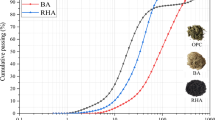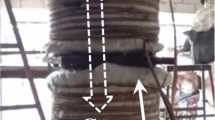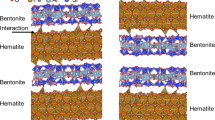Abstract
Blast furnace ferronickel slag (BFFS) has the potential to serve as a supplementary cementitious material (SCM) in the production of cement and concrete. While the composite binder containing BFFS presents varying heat release kinetics under different curing temperatures, the effect of BFFS content on the apparent activation energy (Ea) and temperature sensitivity of the composite cementitious binder has rarely been systematically explored. In this study, the modified ASTM C1074 method with hyperbolic and exponential functions is adopted to calculate the Ea values of the composite binders incorporating different amounts of BFFS via isothermal calorimetry. The results indicate that the calculated Ea values are influenced by different kinetic functions, and increasing the BFFS content from 0 to 50% has significantly elevated the Ea value and enhanced the temperature dependence of BFFS blended cement paste. Moreover, the temperature sensitivity of the composite binder containing BFFS is compared to those containing traditional SCMs, including ground granulated blast furnace slag (GGBFS) and low-calcium fly ash (FA). The study reveals that the Ea value of 50% BFFS blended cement paste is close to that of 50% GGBFS blended cement paste, and higher than that of 50% low-calcium FA blended cement paste. The high temperature sensitivity of BFFS blended cement can be leveraged to promote the early-age strength gain under different curing temperatures.











Similar content being viewed by others
References
Saha AK, Sarker PK. Expansion due to alkali-silica reaction of ferronickel slag fine aggregate in OPC and blended cement mortars. Constr Build Mater. 2016;123:135–42.
Xi B, Li R, Zhao X, Dang Q, Zhang D, Tan W. Constraints and opportunities for the recycling of growing ferronickel slag in China. Resour Conserv Recycl. 2018;139:15–6.
Komnitsas K, Zaharaki D, Perdikatsis V. Geopolymerisation of low calcium ferronickel slags. J Mater Sci. 2007;42:3073–82.
Saha AK, Sarker PK. Sustainable use of ferronickel slag fine aggregate and fly ash in structural concrete: mechanical properties and leaching study. J Clean Prod. 2017;162:438–48.
Choi YC, Choi S. Alkali–silica reactivity of cementitious materials using ferro-nickel slag fine aggregates produced in different cooling conditions. Constr Build Mater. 2015;99:279–87.
Sakoi Y, Aba M, Tsukinaga Y, Nagataki S. Properties of concrete used in ferronickel slag aggregate. In: Proceedings of the 3rd international conference on sustainable construction materials and technologies. Tokyo: Academic; 2013, pp. 1–6.
Bao J, Yu Z, Wang L, Zhang P, Wan X, Gao S, et al. Application of ferronickel slag as fine aggregate in recycled aggregate concrete and the effects on transport properties. J Clean Prod. 2021;304: 127149.
Sun J, Feng J, Chen Z. Effect of ferronickel slag as fine aggregate on properties of concrete. Constr Build Mater. 2019;206:201–9.
Saha AK, Sarker PK. Effect of sulphate exposure on mortar consisting of ferronickel slag aggregate and supplementary cementitious materials. J Build Eng. 2020;28: 101012.
Thompson A, Saha AK, Sarker PK. Comparison of the alkali-silica reactions of ferronickel slag aggregate in fly ash geopolymer and cement mortars. Eur J Environ Civ Eng. 2022;26(3):891–904.
Saha AK, Sarker PK. Potential alkali silica reaction expansion mitigation of ferronickel slag aggregate by fly ash. Struct Concr. 2018;19(5):1376–86.
Nguyen QD, Castel A, Kim T, Khan MSH. Performance of fly ash concrete with ferronickel slag fine aggregate against alkali-silica reaction and chloride diffusion. Cem Concr Res. 2021;139: 106265.
Tomosawa F, Nagataki S, Kajiwara T, Yokoyama M. Alkali-aggregate reactivity of ferronickel-slag aggregate concrete. Spec Publ. 1997;170:1591–602.
Cao R, Li B, You N, Zhang Y, Zhang Z. Properties of alkali-activated ground granulated blast furnace slag blended with ferronickel slag. Constr Build Mater. 2018;192:123–32.
You N, Li B, Cao R, Shi J, Chen C, Zhang Y. The influence of steel slag and ferronickel slag on the properties of alkali-activated slag mortar. Constr Build Mater. 2019;227: 116614.
Huang Z, Wang Q, Lu J. The effects of cations and concentration on reaction mechanism of alkali-activated blast furnace ferronickel slag. Compos Part B Eng. 2022;236: 109825.
Komnitsas K, Bartzas G, Karmali V, Petrakis E, Kurylak W, Pietek G, et al. Assessment of alkali activation potential of a Polish ferronickel slag. Sustainability. 2019;11(7):1863.
Yang K, Yang C, Zhang J, Pan Q, Yu L, Bai Y. First structural use of site-cast, alkali-activated slag concrete in China. Proc Inst Civ Eng Build. 2018;171(10):800–9.
Provis JL, Van Deventer JSJ. Alkali activated materials: state-of-the-art report, RILEM TC 224-AAM. Springer; 2013.
Katsiotis NS, Tsakiridis PE, Velissariou D, Katsiotis MS, Alhassan SM, Beazi M. Utilization of ferronickel slag as additive in Portland cement: a hydration leaching study. Waste Biomass Valorization. 2015;6:177–89.
Li B, Huo B, Cao R, Wang S, Zhang Y. Sulfate resistance of steam cured ferronickel slag blended cement mortar. Cem Concr Compos. 2019;96:204–11.
Rahman MA, Sarker PK, Shaikh FUA, Saha AK. Soundness and compressive strength of Portland cement blended with ground granulated ferronickel slag. Constr Build Mater. 2017;140:194–202.
Lemonis N, Tsakiridis PE, Katsiotis NS, Antiohos S, Papageorgiou D, Katsiotis MS, et al. Hydration study of ternary blended cements containing ferronickel slag and natural pozzolan. Constr Build Mater. 2015;81:130–9.
Huang Y, Wang Q, Shi M. Characteristics and reactivity of ferronickel slag powder. Constr Build Mater. 2017;156:773–89.
Yang T, Yao X, Zhang Z. Geopolymer prepared with high-magnesium nickel slag: characterization of properties and microstructure. Constr Build Mater. 2014;59:188–94.
Wang Q, Shi MX, Zhou YQ, Yu CH. Influence of ferronickel slag powder on the sulfate attack resistance of concrete. J Tsinghua Univ (Sci Technol). 2017;57(3):306–11.
Guan Q, Xia J, Leng F, Zhou Y. Utilizing blast furnace ferronickel slag as paste replacement to reduce white Portland cement content and improve performance of mortar. Adv Bridg Eng. 2021. https://doi.org/10.1186/s43251-021-00039-6.
Li Y, Fang J, Cheng L, He X, Su Y, Tan H. Mechanical performance, hydration characteristics and microstructures of high volume blast furnace ferronickel slag cement mortar by wet grinding activation. Constr Build Mater. 2022. https://doi.org/10.1016/j.conbuildmat.2021.126148.
Sun J, Wang Z, Chen Z. Hydration mechanism of composite binders containing blast furnace ferronickel slag at different curing temperatures. J Therm Anal Calorim. 2018;131(3):2291–301.
Han F, Zhang H, Pu S, Zhang Z. Hydration heat and kinetics of composite binder containing blast furnace ferronickel slag at different temperatures. Thermochim Acta. 2021;702: 178985.
Brooks AG, Schindler AK, Barnes RW. Maturity method evaluated for various cementitious materials. J Mater Civ Eng. 2007;19(12):1017–25.
Poole JL, Riding KA, Juenger MCG, Folliard KJ, Schindler AK. Effect of chemical admixtures on apparent activation energy of cementitious systems. J Mater Civ Eng. 2011;23(12):1654–61.
Chithiraputhiran S, Neithalath N. Isothermal reaction kinetics and temperature dependence of alkali activation of slag, fly ash and their blends. Constr Build Mater. 2013;45:233–42.
Xu Q, Hu J, Ruiz JM, Wang K, Ge Z. Isothermal calorimetry tests and modeling of cement hydration parameters. Thermochim Acta. 2010;499(1–2):91–9.
Schindler AK. Effect of temperature on hydration of cementitious materials. Mater J. 2004;101(1):72–81.
Schindler AK, Folliard KJ. Heat of hydration models for cementitious materials. ACI Mater J. 2005;102(1):24.
Poole JL, Riding KA, Folliard KJ, Juenger MCG, Schindler AK. Methods for calculating activation energy for Portland cement. ACI Mater J. 2007;104(1):303–11.
Lee CH, Hover KC. Extracting kinetic parameters from penetration resistance measurements. Cem Concr Res. 2016;83:140–51.
Bentz DP. Activation energies of high-volume fly ash ternary blends: Hydration and setting. Cem Concr Compos. 2014;53:214–23.
Siddiqui S, Riding KA. Effect of calculation methods on cement paste and mortar apparent activation energy. Adv Civ Eng Mater. 2012;1(1):1–19.
Benaicha M, Burtschell Y, Alaoui AH. Prediction of compressive strength at early age of concrete–Application of maturity. J Build Eng. 2016;6:119–25.
Yikici TA, Chen H-LR. Use of maturity method to estimate compressive strength of mass concrete. Constr Build Mater. 2015;95:802–12.
Tank RC, Carino NJ. Rate constant functions for strength development of concrete. Mater J. 1991;88(1):74–83.
Barnett SJ, Soutsos MN, Millard SG, Bungey JH. Strength development of mortars containing ground granulated blast-furnace slag: effect of curing temperature and determination of apparent activation energies. Cem Concr Res. 2006;36(3):434–40.
Liao Y, Gui Y, Wang K, Al Qunaynah S, Bawa SM, Tang S. Activation energy of calcium sulfoaluminate cement-based materials. Mater Struct. 2021;54(4):1–17.
Day RL, Gamble BR. The effect of changes in structure on the activation energy for the creep of concrete. Cem Concr Res. 1983;13(4):529–40.
Hauggaard AB, Damkilde L, Hansen PF. Transitional thermal creep of early age concrete. J Eng Mech. 1999;125(4):458–65.
Atkins P, De Paula J. Elements of physical chemistry. Oxford University Press; 2013.
Kamkar S, Eren Ö. Evaluation of maturity method for steel fiber reinforced concrete. KSCE J Civ Eng. 2018;22(1):213–21.
Jayapalan AR, Jue ML, Kurtis KE. Nanoparticles and apparent activation energy of Portland cement. J Am Ceram Soc. 2014;97(5):1534–42.
Sun Y, Wang ZH, Park DJ, Kim WS, Kim HS, Yan SR, et al. Analysis of isothermal hydration heat of cement paste containing mechanically activated fly ash. Thermochim Acta. 2022. https://doi.org/10.1016/j.tca.2022.179273.
Bharadwaj K, Isgor OB, Weiss WJ. A Simplified approach to determine pozzolanic reactivity of commercial supplementary cementitious materials. Towar Dev Performance-Based Concr Mix Made with Mod Cem Mater Using Thermodyn Model. 2022;20.
Acknowledgements
This work is supported by CSC Chinese Scholarship.
Author information
Authors and Affiliations
Corresponding author
Ethics declarations
Conflict of interest
The authors declare that they have no known competing financial interests or personal relationships that could have appeared to influence the work reported in this paper.
Additional information
Publisher's Note
Springer Nature remains neutral with regard to jurisdictional claims in published maps and institutional affiliations.
Rights and permissions
Springer Nature or its licensor (e.g. a society or other partner) holds exclusive rights to this article under a publishing agreement with the author(s) or other rightsholder(s); author self-archiving of the accepted manuscript version of this article is solely governed by the terms of such publishing agreement and applicable law.
About this article
Cite this article
Yan, S.R., Sun, Y., Kuang, W.Y. et al. Determination of the apparent activation energy for composite binder containing blast furnace ferronickel slag. J Therm Anal Calorim 148, 7597–7610 (2023). https://doi.org/10.1007/s10973-023-12255-5
Received:
Accepted:
Published:
Issue Date:
DOI: https://doi.org/10.1007/s10973-023-12255-5




